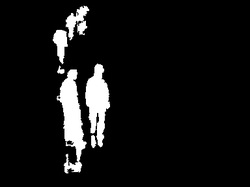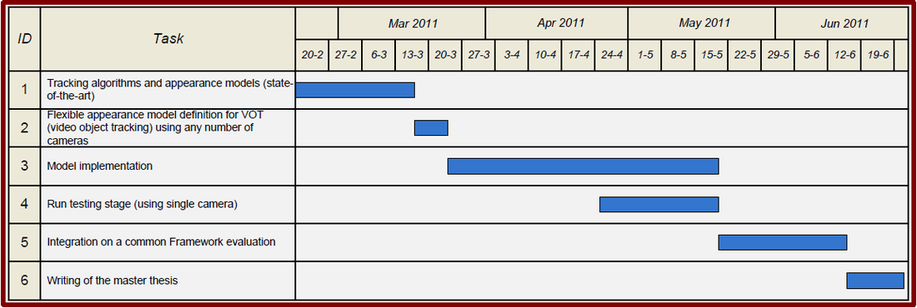Project Page

Nowadays, due to different subjects such as assited living, home automation systems or "crowd modelling", Video Object Tracking (VOT) has been evolving at a constantly rapid pace, getting a lot of scientific breakthrougs and R&D research projects.
Be it in the areas mentioned above, biometrics or even military applications, VOT applications make it possible to track and recognize different kinds of objects in different situations.
Currently I'm studying VOT using differente appearance models (an important topic under study). Using several state-of-the-art approaches, I intend to study how to track and recognize humans using several different approaches.
There are several main approaches to deal with this problem, especially using several state-of-the-art object descriptors (like SIFT (scale-invariant feature transform) or SURF (speeded-up robust features)). However, aside from these obvious choices, it would be interesting to test other recent solutions and variations (hence the appearance models) and test them on a common evaluation platform for a result analysis.
Motivation

Since a few years ago, there has been a constant debate about a major developed countries' concern: an increasingly aging population. This situation will assume even greater proportions in the near future, with the so called "baby-boomer" generation entering retirement age (which some think will pose a great strain on the social welfare system). Since our general life expectancies have been having better prospects, we would have a decreasing ratio of employed/retired citizens on our societies (if the retirement age remains unchanged).
However, an optimistic view of the matter states that an elderly population is not necessarily a problem, since nowadays people are "aging better". If we think about it, the average 60 year old person in 2010 is more lucid and active (also more productive), than its counterpart just 25 years ago.
What if we could help improve even more our quality of life, not just by better health-care, but by assisting our daily tasks? Just to get a general picture of the concept, one can imagine a "smart" house: ordering our weekly groceries, adjusting the garden sprinklers according to the weather, or even make an S.O.S. call in case of emergencies - all of those done automatically. We would have an obvious advantage: what works better for older people, works better for everyone.
Some might argue that all we might grow too comfortable with these automated tasks, but I see it as a logical next step in next-generation housing. Just to give an example: we already know that we don't need to water the garden when it's raining, but why should we adjust that at work from our office (trying to guess if it's raining near our house), when the house system itself could do that? Having people with some sort of locomotion disability in mind, their daily activities could be enhanced by having simple reduntant steps done for them, such as turning off the lights when they leave a room.
However, an optimistic view of the matter states that an elderly population is not necessarily a problem, since nowadays people are "aging better". If we think about it, the average 60 year old person in 2010 is more lucid and active (also more productive), than its counterpart just 25 years ago.
What if we could help improve even more our quality of life, not just by better health-care, but by assisting our daily tasks? Just to get a general picture of the concept, one can imagine a "smart" house: ordering our weekly groceries, adjusting the garden sprinklers according to the weather, or even make an S.O.S. call in case of emergencies - all of those done automatically. We would have an obvious advantage: what works better for older people, works better for everyone.
Some might argue that all we might grow too comfortable with these automated tasks, but I see it as a logical next step in next-generation housing. Just to give an example: we already know that we don't need to water the garden when it's raining, but why should we adjust that at work from our office (trying to guess if it's raining near our house), when the house system itself could do that? Having people with some sort of locomotion disability in mind, their daily activities could be enhanced by having simple reduntant steps done for them, such as turning off the lights when they leave a room.

